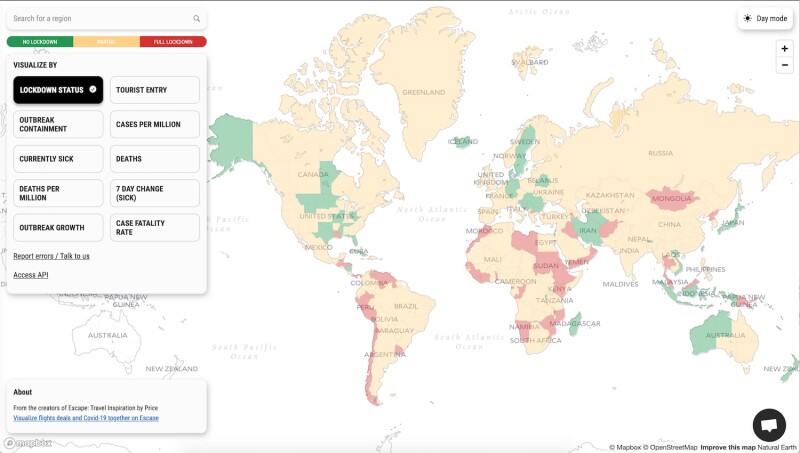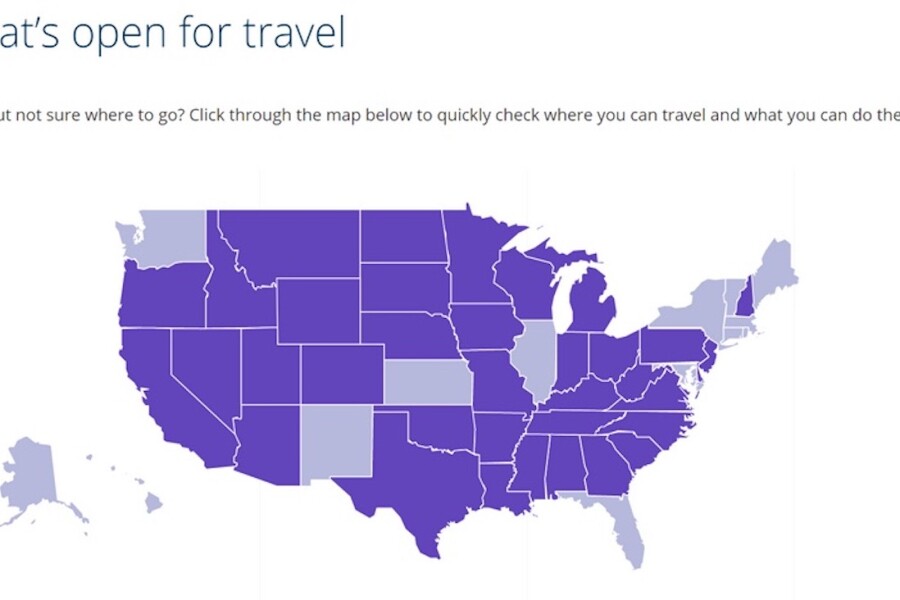Figuring out where you can travel during the coronavirus pandemic has proven to be no small task. In the United States, the rules vary from state to state—some states have mandatory quarantines, others have COVID-19 testing requirements, and some have no entry restrictions at all. And they often differ depending on which state you are coming from and going to. The web of restrictions is equally complicated for international destinations. What’s worse, they’re constantly changing.
Thankfully, several companies and organizations have created dynamic, interactive domestic and international maps designed to provide the most up-to-date COVID-19 travel information. Here are the ones we have found to be most useful.
United Airlines’ Destination Travel Guide
Launched in September, United’s interactive map is available online as well as on the United mobile app. There is a United States and global version of the carrier’s Destination Travel Guide, a color-coded digital map that lets travelers know whether each state or country is closed, partially open, or fully open for travel. When you click on a state or country, a pop-up window indicates whether COVID-19 testing, a quarantine, and/or travel health forms are required for entry. You can then click on a “see more info” tab that reveals whether face coverings and social distancing are required and whether (and which) businesses are open, closed, or open with limitations.
The Destination Travel Guide is intended to be “a simple, easy tool that helps customers decide where to travel next,” United’s chief digital officer Linda Jojo said in a statement.
What we love about it: It’s really nice to have access to both domestic and international travel requirements all in one place. The global map is particularly thorough in that it allows users to enter any origin country and any destination country, which makes this a great tool for international travelers regardless of where they live or work.
The International Air Transport Association’s Interactive COVID-19 Map
If there is any entity that’s most in need of reliable and au courant information, it’s the global aviation industry. Enter the International Air Transport Association’s (IATA) interactive world map, which offers the latest COVID-19 entry regulations by country.
This map provides up-to-the-minute (seriously, it’s updated more than 200 times per day) information on international travel restrictions based on your citizenship and country of residence.
The map is accessible both on desktop and mobile devices for easy access wherever you are. You can also sign up for a COVID-19 travel alert service, real-time notifications for all travel updates related to the pandemic (the alerts are not free—you have to contact IATA to get a quote).
What we love about it: You’d be hard-pressed to find an international travel resource updated as frequently as this one.
COVID Controls

This map combines travel information with the latest COVID-19 health data.
Courtesy of COVID Controls
Back in June, a COVID-19 travel tracking tool called COVID Controls was developed by Escape, a team of engineers from the Massachusetts Institute of Technology (MIT). The smart international map they created (which also has state-by-state information for the U.S.) delivers a wide range of detail: mask mandates, arrival requirements, whether quarantine or testing is needed, and what kind of lockdown measures are in effect.
But what’s particularly helpful? It provides the latest coronavirus statistics: case counts, increases or decreases in cases over the last seven days, and whether the outbreak is trending towards containment or is on the rise.
What we love about it: You’ll often find either very thorough coronavirus updates, such as the Johns Hopkins University domestic and global tabulations regarding COVID-19 cases and deaths, or good travel resources, such as the United and IATA tools mentioned above. It’s really helpful to have a tool that brings both together.
When it comes to navigating travel restrictions amid the coronavirus pandemic, the best approach we have found is relying on a combination of sources. Cross reference maps such as these against news reports and updates issued directly by government agencies and tourism boards.








